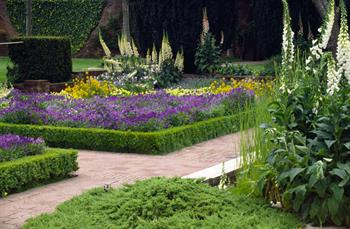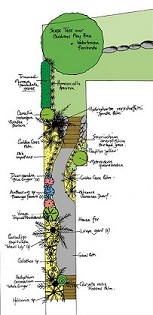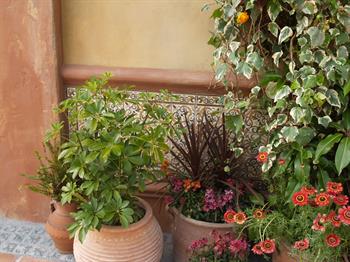COURSE STRUCTURE AND CONTENT
Course Duration: 100 hours.
Start Date: Start at any time - study at a pace that suits you, and with full tutor support for the duration of your studies.
Lessons: The course comprises 10 lessons as detailed, below.
1. Designing Gardens
- The basics of design concepts through to understanding how to use them.
2. Styles of Gardens
- Formal, informal, natural, and other themes.
3. Drawing Plans - Designing Gardens
- Learn how to draw basic landscape features and garden designs.
4. Understanding Soils
- Clays, loams, sands - how to identify them and treat them for better plant growth.
5. Basic Landscape Construction
- What is involved to build basic structures like steps, walls, paths, etc.
6. Weeds & Pests
- How to identify and treat garden weeds and pests.
7. Planting and Pruning
- Techniques to plant, prune and care for garden plants.
8. Lawns, paving and other surfacing
- Care for various surfaces
9. Garden Features
- How to select and use garden features in a landscape.
10. Developing Your Garden - Special Project

ASSIGNMENTS
Each lesson is completed with an assignment. The 10 assignments in this course will require written answers to set questions (sometimes drawings), plus a series of plant reviews.
6 plants are to be illustrated and reviewed with each assignment. Each plant should be labeled with both scientific and common names plus details of size and shape, conditions it will grow in, maintenance requirements, lifespan, appearance (and any way it's appearance might change throughout the year) plus several recommendations as to suitable situations it could be used in by the landscaper.
Topics covered include: designing gardens, styles of gardens, drawing plans, understanding soils, basic landscape construction, weeds and pests, planting and pruning, lawns and other surfacing, garden features, plus a special project to help you develop your own garden.
Get to Know the Plants
 Choosing the right plants, and using them in the right way, can make or break a garden.
Choosing the right plants, and using them in the right way, can make or break a garden.This is why we have incorporated a lot about plants throughout this course.
Landscapes must always have good solid construction. This is what we call hard landscaping. Hard landscaping involves the fences, paths, walls, drainage, soil levels and improving the structure and fertility of soil. When these parts are done right; you will have a great framework to put your plants into; but the wrong plants in the right place can turn a potentially stunning garden into something that doesn't function; and looks terrible.
What then is right? Here is an example of the type of things you will need to learn.
Trouble-Free Plants for Small Areas
How often have you bought on impulse at the nursery, only to find that elegant little plant that looked so neat and well behaved in its pot grew into a forest giant when planted out in the garden?
Such plants not only look out of scale, but also compete with other plants for water and nutrients. They can be messy and cast too much shade, and can be dangerous and expensive to remove. Careful plant selection will ensure that everything “fits in” and stays in proportion to the other features of the garden.
As with any garden, good planning and preparation are important. Ensuring that you have prepared your soil well, provided good drainage, and installed irrigation systems before you consider any plantings will minimise the likelihood of problems.
Types of plants to grow in small gardens
Plants with the following characteristics are suited to small areas:
- Non-invasive roots. Plants with suckering, invasive roots have the potential to cause havoc in small areas where they are in close proximity to foundations, underground pipes and paved surfaces. (Note that any plant root can enter a crack or a join in a sewerage pipe, but those with invasive roots will cause far more damage.)
- Small-growing, or can easily be kept small. As a general rule 5-7 metres is the upper limit for tree height in a small garden. Remember that soils and climate will affect the eventual height of a plant, eg. a tree that grows to 6 metres out in the bush may grow two or three times that height in a sheltered backyard with rich soil and plenty of water. It’s preferable to choose plants that are small growing, rather than pruning to limit their height. Too often we find we don’t have the time we hoped we would to keep such plants in check, and they soon outgrow their welcome. It can also be difficult to store and dispose of the prunings in a small area.
-
Slender habit, or trees that have most of the canopy well above head height. Taller-growing trees, ie. those that grow taller than 6 m can still be grown in small gardens, providing they have a narrow form, such as silver birches. You will still need to consider how the tree fits in with the surrounding plants.
- Pest and disease resistant. A confined space will usually have much less ventilation than more open gardens, so it is preferable to avoid having to use chemical controls.
- Interesting features such as unusual bark, colourful flowers and leaves, attractive fruits, etc. Every plant counts in a small area, so choose those which put on a good display for more than just a few days of the year.
Dwarf Plants
Many commonly grown plants have dwarf forms that enable you to enjoy many of your favourites, but in a much more compact form. Examples include:
- Dwarf fruit trees, such as the Ballerina series of apples, or dwarf citrus.
- Miniature roses.
- Dwarf or compact conifers – there is a huge range of shapes, colours and textures. Many are slow growing, making them ideal for gardens with limited space.
Strategies for growing plants in small areas
- It’s better to use several smaller plants rather than one large one to give the impression of greater space.
- Grow plants in containers to keep them compact.
- Use water well pots instead of plastic or terracotta pots, especially in courtyards that become quite hot in summer. Water well pots have a reservoir of water at the base of the pot, so you only need to refill them occasionally.
- Limit root growth problems by providing root barriers when first constructing the garden.
- Avoid overcrowding plants.
- Use only a few plants with large leaves, as these make the plant seem bigger.
- Espaliers are an effective way of covering up a blank wall, and making good use of limited space.

Student Testimonial
"This is the first correspondence course I have done and I have thoroughly enjoyed it and I just wanted to say a big THANK YOU. I appreciate everyone's effort in such a professionally-run organisation with seamless administration. The office staff's happy can-do attitude, their fast responses to all queries, tutor Shane's quick turn around in assignment marking and his supportive and motivational feedback and last but not least, the sound subject guides. Most importantly I hope my thanks and appreciation can be communicated to all the staff who have supported me along the way of my learning! I work full time and study on the weekend but really don't stop thinking about what gardening solution I need in order to answer my assignments every day of the week. Thank you for such a great learning experience and I can't wait to start the second half of my course!!"
- Skye
HOW THE COURSE WORKS
You can start the course at any time.
It is studied by distance learning, so you can study in the comfort of your own home. But this doesn't mean you are all alone in your studies. Our highly qualified and friendly tutors are there to help you every step of the way. If you have any questions at all, they are always happy to help.
THE ADVANTAGES OF STUDYING WITH ACS
- You can start the course at any time and study at your own pace.
- Fit your studies around your own busy lifestyle - we provide full tutor support for all the time you are studying.
- Study where you want to - online studies offer the flexibility for you to determine where and when you study.
WHY SHOULD YOU STUDY THIS COURSE?
- Learn to design, construct and develop your own garden.
- Take the first step to a new business career in home landscaping.
- Improve the value of your own property with your own exclusive landscape design.
- Learn how to look after and maintain a garden
WHAT NEXT?
Enrol
Go to “It’s Easy to Enrol” box at the top of the page and enrol now.
Get Advice
Email us at info@acsedu.co.uk or use our FREE COUNSELLING SERVICE to contact a tutor.